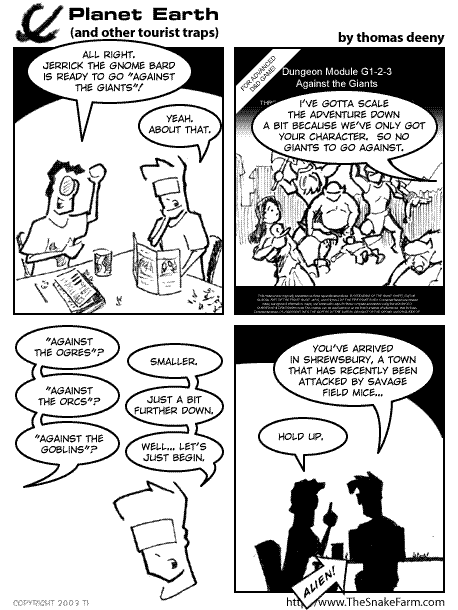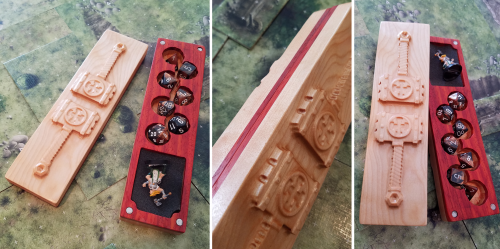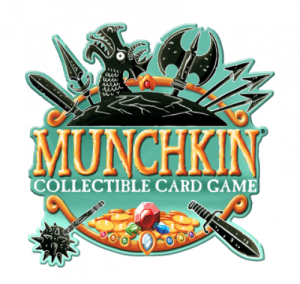 Launching at retail next week is the Munchkin CCG from Steve Jackson Games. And to jump right away on your first question, no, it’s not just the Munchkin card game in new packaging. The CCG would be better described as Munchkin-inspired. The game features similar humor and artistic style and borrows many thematic elements. It’s still a parody of fantasy roleplaying. Levels and loot are part of the game. And traditional Munchkin-y things show up on various cards—ducks, chainsaws, and gazebos are just a few.
Launching at retail next week is the Munchkin CCG from Steve Jackson Games. And to jump right away on your first question, no, it’s not just the Munchkin card game in new packaging. The CCG would be better described as Munchkin-inspired. The game features similar humor and artistic style and borrows many thematic elements. It’s still a parody of fantasy roleplaying. Levels and loot are part of the game. And traditional Munchkin-y things show up on various cards—ducks, chainsaws, and gazebos are just a few.
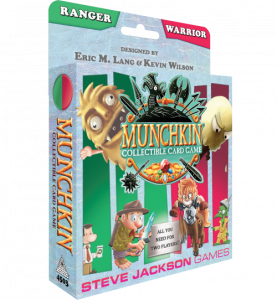 Gameplay, however, is quite different. It is a CCG, so the essential idea is to attack your opponent and reduce their hero’s life points to zero. The way cards work together, too, is an important part of the game. In fact, each player chooses a hero of a specific class (elf thief or dwarf cleric, for example) and the cards of their deck are all supposed to either belong to that class or be neutral. The cards of each class type, of course, build on a common theme. Cleric cards allow the player to resist damage or heal. Thief cards lean toward the Mischief type (special actions or attacks that can be played out of normal order).
Gameplay, however, is quite different. It is a CCG, so the essential idea is to attack your opponent and reduce their hero’s life points to zero. The way cards work together, too, is an important part of the game. In fact, each player chooses a hero of a specific class (elf thief or dwarf cleric, for example) and the cards of their deck are all supposed to either belong to that class or be neutral. The cards of each class type, of course, build on a common theme. Cleric cards allow the player to resist damage or heal. Thief cards lean toward the Mischief type (special actions or attacks that can be played out of normal order).
 All that is fine and good. But what makes the Munchkin CCG outstanding is how brilliantly it pairs serious game with silly humor and take-that attitude. To attack your opponent, you send out one monster at a time with the money to pay for it. The card you put forward, however, goes face-down and need not even be a monster, or maybe you paid too little, or too much. Your opponent then has a choice to make, whether to defend, or runaway, or simply stand and take the hit—all while trying to read your bluff. “Cheating,” as it’s called (attacking without a monster or the money to pay for it), is part of the game, and part of the strategy in getting past an opponent’s defenses.
All that is fine and good. But what makes the Munchkin CCG outstanding is how brilliantly it pairs serious game with silly humor and take-that attitude. To attack your opponent, you send out one monster at a time with the money to pay for it. The card you put forward, however, goes face-down and need not even be a monster, or maybe you paid too little, or too much. Your opponent then has a choice to make, whether to defend, or runaway, or simply stand and take the hit—all while trying to read your bluff. “Cheating,” as it’s called (attacking without a monster or the money to pay for it), is part of the game, and part of the strategy in getting past an opponent’s defenses.
Bluffing and cheating also makes the Munchkin CCG much more than just playing your cards against your opponent’s deck. You’re really playing your opponent.
At launch, the Munchkin CCG will be available in two-deck Starter Sets (Cleric/Thief, Wizard/Bard, Ranger/Warrior) for $20 and 12-card boosters for $4.
- Comments Off on Second Look—Munchkin CCG
 What a beautiful game! From the box art to the playing boards, even the the cards and tokens, Rayguns and Rocketships from IDW Games is fantastically illustrated with a retro sci-fi style. Four factions are included in the game: the Astro-Rangers, the Star-Pirates, the Zard, and the Blaarg. Each has its own set of crew, captain, and rocketship miniatures with a unique look. That Blaarg flying saucer with its tail-fins!
What a beautiful game! From the box art to the playing boards, even the the cards and tokens, Rayguns and Rocketships from IDW Games is fantastically illustrated with a retro sci-fi style. Four factions are included in the game: the Astro-Rangers, the Star-Pirates, the Zard, and the Blaarg. Each has its own set of crew, captain, and rocketship miniatures with a unique look. That Blaarg flying saucer with its tail-fins!
The basic outline of gameplay also has a lot going for it. Players get to maneuver the rocketships around obstacles in space, shooting rayguns at each other and launching crew through the ether on boarding actions. In addition to a star map for the ships and flying crew (with individual rocket-packs), the game has separate rocketship map boards where the players can move their crew to perform specialized actions—for example, placing a crew member on an engine space gives the ship an extra move on the space map. And to accomplish all this, the players program a selection of command cards at the start of each round, then hope enemy ships stay within range of their mounted raygun ports.
 Unfortunately, the game’s fantastic theme and graphic presentation aren’t enough to overcome a lousy rulebook, even for this die-hard science fiction fan. It’s shortcomings include poor organization, inconsistent terminology, and vague instructions. Completing a game took guesswork, including about the victory conditions for a scenario.
Unfortunately, the game’s fantastic theme and graphic presentation aren’t enough to overcome a lousy rulebook, even for this die-hard science fiction fan. It’s shortcomings include poor organization, inconsistent terminology, and vague instructions. Completing a game took guesswork, including about the victory conditions for a scenario.
I may keep the figures to display on my shelf but I won’t be playing Rayguns and Rocketships again.
A complimentary copy of Rayguns and Rocketships was provided by IDW Games for review.
- Comments Off on Second Look—Rayguns and Rocketships
 Xanathar’s Guide to Everything from Wizards of the Coast is the first dedicated book of expansion rules for Dungeons & Dragons 5th edition. As a rule book it presents many game-enhancing options for players—character subclasses, spells, magic items—and tools for dungeon masters—trap design, encounter building, area-of-affect adjudication. Among the new subclasses (those path-of-specialization choices made by everyone somewhere between 1st and 3rd level) it’s the Bard College of Whispers, Samurai (Fighter), and Scout (Rogue) that most attract me. However, every one provides a unique path for players to explore, some magical, some martial, some mystical.
Xanathar’s Guide to Everything from Wizards of the Coast is the first dedicated book of expansion rules for Dungeons & Dragons 5th edition. As a rule book it presents many game-enhancing options for players—character subclasses, spells, magic items—and tools for dungeon masters—trap design, encounter building, area-of-affect adjudication. Among the new subclasses (those path-of-specialization choices made by everyone somewhere between 1st and 3rd level) it’s the Bard College of Whispers, Samurai (Fighter), and Scout (Rogue) that most attract me. However, every one provides a unique path for players to explore, some magical, some martial, some mystical.
The rules section, though, that I see most enhancing my game has to be the one on tool proficiencies. It provides some great ideas on how to use a piece of the game that in my experience is not well understood, and therefore mostly ignored. For example, it describes what use to make of a disguise kit, gaming set, and thieves’ tools. It also explains how to view a task that might benefit from both a skill proficiency and a tool proficiency, and what specific additional insights a character with both might realize.
But with all that, what really distinguishes Xanathar’s Guide is its focus on providing options to enhance the game’s story. That is, it’s more than just a book of mechanical rule options. Yes, you’ll find in it cool powers for your characters but more importantly, you’ll find in it ideas for cool backstories. The book has tables of suggestions for family history, rivals, mentors, personal keepsakes, life tragedies, and even a “weird stuff” list. Xanathar’s Guide also provides new feats specific to the various races and tables of character names by race and human-historical culture. As well, there’s a whole section on things that characters might do during their between-dungeon downtime, such as gambling, training, carousing, research, crafting, and more—and how a dungeon master might evaluate their success.
Now, I’m not going to say it does these things perfectly. The little sidebar notes from Xanathar, a well-known beholder out of the Forgotten Realms, I found just silly, though they’re small and easy to ignore. And the tables of random encounters, I thought were a wasted opportunity, pretty much listing groups of monsters, where there could have been more ideas for interesting locations, traveling groups, or even monsters with specific goals.
Nevertheless, Xanathar’s Guide to Everything is definitely one of the better and more inspiring RPG books I’ve encountered.
Xanathar’s Guide to Everything hit the shelves of local game stores today and can be found in general retail November 21st. The suggested retail price in $49.95.
A complimentary copy of Xanathar’s Guide to Everything was provided by Wizards of the Coast for review. Actually two, but we gave one away earlier this week.
- Comments Off on Second Look—Xanathar’s Guide to Everything
 Breaking Games has been a roll lately not only with great games but getting those games into retail. One of my favorites of theirs to hit store shelves? That’d be MoonQuake Escape, now on over 650 Barnes & Nobles store shelves.
Breaking Games has been a roll lately not only with great games but getting those games into retail. One of my favorites of theirs to hit store shelves? That’d be MoonQuake Escape, now on over 650 Barnes & Nobles store shelves.
In MoonQuake Escape each player plays a convict on the prison planet of Zartaclaton. A major quake has put the plant into a tailspin, freeing the prisoners and having them all scramble to try and use the last escape pod to get outta dodge before everything goes bottom-end up. It’s not a straightforward race for freedom, though. The planet’s surface is constantly shifting, making it difficult for the convicts to make their way to the pod. Toss in a prison guard that’s still operational and they’ve got quite the task to accomplish.
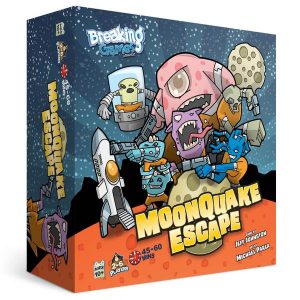 MoonQuake Escape’s board is made of several rings that are stack on each other so they can spin. This represents the unstable nature of Zartaclaton. Each turn players will get a certain number of charges to make various actions: moving, playing cards, peeking at other player’s cards, escaping hazardous territory, etc… Players keep played cards, except equipment, face down. One of these cards is their alien convict. The only way to move and eventually escape is to keep this card hidden. If it’s revealed you’ll have to take some penalties and get it hidden again to progress through the game. This makes bluffing very important. Have a shield card? It may be too obvious to protect your alien, but placing it elsewhere may open you up for discovery.
MoonQuake Escape’s board is made of several rings that are stack on each other so they can spin. This represents the unstable nature of Zartaclaton. Each turn players will get a certain number of charges to make various actions: moving, playing cards, peeking at other player’s cards, escaping hazardous territory, etc… Players keep played cards, except equipment, face down. One of these cards is their alien convict. The only way to move and eventually escape is to keep this card hidden. If it’s revealed you’ll have to take some penalties and get it hidden again to progress through the game. This makes bluffing very important. Have a shield card? It may be too obvious to protect your alien, but placing it elsewhere may open you up for discovery.
Overall the game is a great time. It’s silly fun with a good mix of chaos and strategy. It’s more than just a cool gimmick. It’s a solid family game that I know I’ll keep coming back to with my kids.
- Comments Off on Second Look—MoonQuake Escape
Second Look—The Toy Box
27 Apr
Posted by David Miller as Card Games, Electronic Games, Modern Board Games, Other
 Eh. After watching three episodes of The Toy Box, the toy-focused, Shark Tank like television show on ABC, I’m not impressed. Though, perhaps I’m jaded from 9 years attending Toy Fair… Actually, some of the toys in the first three episodes of The Toy Box weren’t bad. But not bad just doesn’t cut it. I mean, Mattel, who promises to produce the winning toy, doesn’t need a televised national competition to come up with dolls that have ballet costumes and a couple of extra degrees of articulation.
Eh. After watching three episodes of The Toy Box, the toy-focused, Shark Tank like television show on ABC, I’m not impressed. Though, perhaps I’m jaded from 9 years attending Toy Fair… Actually, some of the toys in the first three episodes of The Toy Box weren’t bad. But not bad just doesn’t cut it. I mean, Mattel, who promises to produce the winning toy, doesn’t need a televised national competition to come up with dolls that have ballet costumes and a couple of extra degrees of articulation.
Not that a decently made new doll, or nested foam sports balls, couldn’t find some room in the marketplace. These ideas, though, do nothing for a large established toy company like Mattel, which has many designers on staff, as well as existing relationships with experienced outside inventors. Frankly, I don’t think the average viewer either is going to be much impressed.
The concept, I believe, has a lot of potential but the first three episodes so far haven’t realized it. The mentors representing the first on-screen evaluation stage are far too calm and gentle. Here’s a guy who sold his house and moved back in with his mother to finance production of a kind of plush he didn’t realize was already in the market from a different company. Another contestant’s brilliant idea is to make a stiff curved swing-set seat specifically for kids to stand on. Does that really require $130 specialized equipment? Definitely not. But throughout, the panel of expert mentors is calm and polite and barely challenges the inventors other than to express “concerns”. Liven it up guys!
By the way, let me say from personal experience, with an emergency room visit and stitches to the head, that standing on a swing-set seat is not a safe activity for children!
The second evaluation stage in each episode—before a panel of four children judges—you’d think would be a lot more fun to watch. Unfortunately, it just isn’t. Eleven year-old actors paid to look young and recite adult lines are lacking in chemistry and spontaneity.
Now maybe you think differently. Maybe you have more confidence in what will come out of this series. If so, you should know that the final chosen toy—whatever that will turn out to be—is already in production and will be sold exclusively at Toys “R” Us beginning May 20th. Toys “R” Us is also running a sweepstakes, where the grand prize includes travel for four to Los Angeles, a tour of Mattel headquarters, $1,500 in gift cards, and a meeting with the show’s winning inventor.
Also, if you think you have the perfect toy or game for Mattel, MysticArt Pictures is already casting inventors for a second season. And a U.K. version of the show has been licensed to Electus International. Maybe that one will be better. I hope so.
- Comments Off on Second Look—The Toy Box
 Tales from the Yawning Portal. I’m not sure what to make of this product, but let’s start.
Tales from the Yawning Portal. I’m not sure what to make of this product, but let’s start.
The book is a collection of classic Dungeons & Dragons adventures updated for Fifth Edition, arranged so one could just go through each in order with a group of characters, campaign-like. None of the adventures link to any other. This is a book of nostalgia, bringing adventure modules from the early days of Dungeons & Dragons to “D&D Next” up to speed with current rules.
 Aside from the nostalgia factor, I’m not certain why this book exists the way it does. Fifth Edition’s adventure offerings sold in stores have mainly been campaign-driven, from Tyranny of Dragons through Storm King’s Thunder. One-off adventures have been limited to the organized play program run at game stores. To me, it makes more sense to use a collection of those adventures to show 5e Dungeon Masters how to structure a 5e adventure.
Aside from the nostalgia factor, I’m not certain why this book exists the way it does. Fifth Edition’s adventure offerings sold in stores have mainly been campaign-driven, from Tyranny of Dragons through Storm King’s Thunder. One-off adventures have been limited to the organized play program run at game stores. To me, it makes more sense to use a collection of those adventures to show 5e Dungeon Masters how to structure a 5e adventure.
Take Tomb of Horrors, a classic adventure module. The design for this 1970s module doesn’t look like what design in the 2010s should be: the adventure is mainly linear and has a more adversarial DM versus player mindset than games in the past few decades have been. Despite this edition’s claim that Tomb of Horrors was supposed to be a “thinking person’s adventure”, TSR’s Lawrence Shick said the traps in the adventure were intended “not to challenge the intruders but to kill them dead.” (Wizards of the Coast from a few years back even wrote, “Gygax’s main purpose in creating Tomb of Horrors was to take his players down a peg.”)
The version I played, back when D&D was Advanced, involved several instances where you had to make saving throws or your character would die. Fifth Edition really goes out of its way to keep player characters from dying from a bad die roll or two, but in this update there are still plenty of insta-death: “…which is fatal, and all the characters in the … area are dead, with no saving throw, while any in the [nearby area] are slain unless they succeed on a DC 17 Constitution saving throw.” “Roll initiative. On initiative count 10, anyone still in [the area] is crushed against the roof and slain.”
But people love Tomb of Horrors. They want to play it. They’ve heard the stories. Can I survive the gauntlet, they wonder. Perhaps we all just make three or four level 18 heroes and see if we can get to the end. It’s part of D&D history, like Eric and the Gazebo or The Head of Vecna.
I feel that the form factor of the book hampers the re-envisioning of these classic adventures. The original version of Tomb of Horrors came with a twenty-page booklet of images for players to reference. When looking at a portal, for example, players could describe exactly what element they’re manipulating, or perhaps the illustration of an intricately detailed lock will give players a clue to solve the puzzle. Back when AD&D was around, there weren’t any skill checks — almost all of the solutions had to come from the players, not the characters.
These adventures (the older ones) also were originally published with a detached cover. The paper booklet would have the printed adventure, the cover (which could be used as a DM screen) had the maps for the adventure easy to access. As a hardcover book, the maps are printed in the pages of the book, leaving us with Dead in Thay’s massive Doomvault taking up all of page 111 with crazy tiny type and grid. (This map must have been printed as a poster-sized thing as we’re looking at a grid with about 25 divisions per inch.) However, I do like how they solve the solution for that adventure: closeups of the map appear in the adventure near relevant area descriptions. It’s a good way to keep access to the map near the important information.
Other adventures do this, like the Forge of Fury, but most are “here’s a map you’ll have to keep flipping back to” like the sprawling fortress level of The Sunless Citadel.
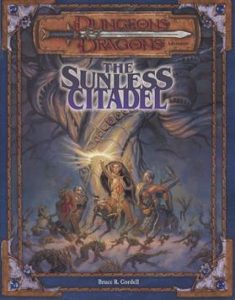 And while we’re at The Sunless Citadel, we’re going to loop back to 5e adventure design. This adventure was the first offering for D&D Third Edition. I’m not certain if people have the same nostalgic feeling for this (or Forge of Fury, the second in the line and in the book) as they did for Ravenloft, which begat Curse of Strahd, or this book’s Tomb of Horrors. But regardless, it seems to be a strange thing to include in this collection.
And while we’re at The Sunless Citadel, we’re going to loop back to 5e adventure design. This adventure was the first offering for D&D Third Edition. I’m not certain if people have the same nostalgic feeling for this (or Forge of Fury, the second in the line and in the book) as they did for Ravenloft, which begat Curse of Strahd, or this book’s Tomb of Horrors. But regardless, it seems to be a strange thing to include in this collection.
Take the first real area the adventurers access, the crumbled courtyard of the fortress. The floor of the courtyard is roughly twenty-five feet across to the entrance, but the floor is positively choked with rubble that slows movement. Why does it slow movement? No external threat exists: no time constraint to counter, no enemy able to spot the heroes the longer they stay out in the open. Just a series of DC 10 Acrobatics checks that stops movement if failed, or, if failed by five or more, prompts a 10% chance of a giant rat attack. “This encounter is why skill challenges were created,” writes a friend of mine. If you don’t fail any rolls badly enough, no rats to fight.
But that’s not all this area features. There’s a trap door that’s ten feet wide by ten feet long that drops people into a pit ten feet deep, which was triggered yesterday. Presumably, when the pit trap was triggered yesterday and the floor hinged downward, dumping the luckless goblin whose corpse is now below, all the rocks and debris and rubble also were dumped here. So when the heroes encounter this area, wouldn’t they see right in the center of this field of rubble a clear 10’x10′ square? Or are all the rocks magically glued to the pit trap cover, which is triggered by weight?
And the trap is only ten feet deep with the door hinged on one side, so all one really has to do is hop up when the door resets itself a minute later to climb out, assuming the door isn’t jammed into place with all of the rock that fell in, too.
Puzzled by the logic of this encounter — the first actual place in this adventure where things happen — I flipped ahead to a random room description in The Sunless Citadel, coming across a reference to make a DC 20 Wisdom (Perception) check. And then I glanced at the other area descriptions on the spread. They all call for Wisdom (Perception) checks. Flip to the previous page. “With a successful DC 15 Wisdom (Perception) check…” Flip forward. “With a successful DC 15 Wisdom (Perception) check…” “A successful DC 15 Wisdom (Perception) check made while searching…” Flip. “…separate DC 15 Wisdom (Perception) checks uncover…”
This is odd adventure design.
While there are some Strength checks, some Intelligence (Investigation) checks, and some Dexterity checks (and some Dexterity skill checks) in the adventure, it looks like the majority of things a character in Fifth Edition will do that’s not fighting is… perceiving. Just thumbing through the numbered encounter areas for the fortress level, there are twenty-one Wisdom (Perception) checks with the next most-numerous check to be made are either the seven basic Dexterity checks to unlock things with lockpicks or, if we’re looking at the skill list, the four Intelligence (Investigation) checks which are mostly made immediately after succeeding on a Perception check.
Again. Strange adventure design.
But there are elements baked into The Sunless Citadel for role-playing scenes, which is cool. It’s not all fights and Perception checks.
Forge of Fury is a better adventure (actually ranked #12 of D&D adventures of all time by gaming industry professionals in Dungeon magazine’s November 2004 issue). Christopher Perkins wrote, “To survive this adventure, the heroes must function as a team. The foes are smart and use their lairs creatively, and the black dragon at the end shows you don’t need a 20-foot wingspan to send adventurers screaming for their lives.”
The Hidden Shrine of Tamoachan is a mostly-linear trek through a Mayan/Aztec-flavored dungeon with a bit of an Indiana Jones-like trap-filled tomb feel. Like Tomb of Horrors, this originally came with a booklet of player handouts.
 White Plume Mountain comes next (which I’ve always confused with Expedition to the Barrier Peaks), which is more of a less-lethal version of Tomb of Horrors. It’s a small dungeon with rooms that are crazy fun. Clark Peterson in that Dungeon magazine article says, “A battle against a giant crab in a dome at the floor of a volcanic lake? Check. Reverse gravity water tubes with kayaking bad guys? Check. A completely frictionless surface, studded with pit traps? Check.”
White Plume Mountain comes next (which I’ve always confused with Expedition to the Barrier Peaks), which is more of a less-lethal version of Tomb of Horrors. It’s a small dungeon with rooms that are crazy fun. Clark Peterson in that Dungeon magazine article says, “A battle against a giant crab in a dome at the floor of a volcanic lake? Check. Reverse gravity water tubes with kayaking bad guys? Check. A completely frictionless surface, studded with pit traps? Check.”
But then we get to Dead in Thay, which should be the closest thing to adventure design for Fifth Edition. This adventure was created for D&D Next, the playtest verison of what would eventually become the current edition of the game. It’s a gigantic adventure that’s a massive dungeon crawl, with the dungeon split up into different zones, presumably one zone for each week of the D&D Encounters organized play program. But like Tomb of Horrors, this was “a tribute to killer dungeons from the game’s history”.
So of the seven adventures published here, four are in the mold of the killer dungeon: Tomb of Horrors, Dead in Thay, The Hidden Shrine of Tamoachan, and White Plume Mountain.
The last we haven’t mentioned yet is Against the Giants, the bit of nostalgia that lies in wait to entrap me.
I remember running this back in the days of Advanced Dungeons & Dragons and loved it. It had direct ties into the drow series (Descent into the Depths of the Earth, Shrine of the Kuo-Toa, Vault of the Drow) and the Queen of the Demonweb Pits. Previously adapted for Fourth Edition, the maps have reverted back to approximations of the originals. (Fourth Edition needed large areas for combats due to the design of that system. Even the hallways and rooms of Hill, Frost, and Fire Giants weren’t nearly ludicrously large enough to handle combats in that edition!)
Rather than just have the adventure be the first of the three giants adventures, WotC counts all three of these as one large Against the Giants adventure. (The three adventures were repackaged as one huge module in the AD&D era.) The adventure’s start is nebulous here — I can’t recall if the originals had things happen before the heroes attack the steading of the hill giant chief or not — your heroes are “given the charge to punish the miscreant giants” being told that they can keep all the loot they find. Now, let’s ignore that the map of the timber fortress of the hill giants appears to be structurally unsound, or that the icy and rocky caves of the frost and fire giants just happen to end in a rectangular shape that fills a letter-sized piece of paper. I’m looking at this with fond memories. But in the back of my mind, I’m wondering about Storm King’s Thunder.
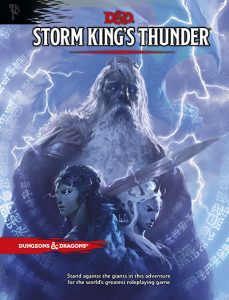 As we’ve covered last year, Storm King’s Thunder is more of a Fifth Edition riff on Against the Giants. While Storm King’s Thunder and this have interesting locales for the antagonists and interesting ways to deal with them, Against the Giants‘ setting seems more of a dungeon crawl; Storm King’s Thunder feels more like elements that would naturally occur in the fantasy setting of Dungeons & Dragons.
As we’ve covered last year, Storm King’s Thunder is more of a Fifth Edition riff on Against the Giants. While Storm King’s Thunder and this have interesting locales for the antagonists and interesting ways to deal with them, Against the Giants‘ setting seems more of a dungeon crawl; Storm King’s Thunder feels more like elements that would naturally occur in the fantasy setting of Dungeons & Dragons.
When I look back at Tales from the Yawning Portal, I realize I’m interested in Against the Giants because of that nostalgia feeling. I want to play this again. That’s exactly what this book is about. It’s not a good book for someone new to D&D, someone that has only experienced 5e. They would look at these adventures and walk away, confused. It’s not for them.
It’s a book for the older players.
It’s a book for the ones that came in during Third Edition with The Sunless Citadel and The Forge of Fury. The ones from the days of Advanced D&D with Against the Giants and Tomb of Horrors. The ones from the early days of D&D with White Plume Mountain and The Hidden Shrine of Tamoachan.
It’s not a good book for someone looking to run 5e games. But it is a good book for seeing how the games you played in your early days of roleplaying would work with the contemporary ruleset.
So what is this book?
The book is a collection of classic Dungeons & Dragons adventures updated for Fifth Edition, arranged so one could relive adventures from one’s gaming youth; a book of nostalgia, bringing adventure modules from earlier editions of Dungeons & Dragons into the current ruleset. And that’s good enough for me.
Addendum: I just received a copy of Curse of Strahd, which has a map of the area (and several locations) bundled in the back like a fold-out poster. I don’t see why they didn’t do something similar here, with perhaps the player’s map of the Doomvault on one side and the other side, in each folded section, maps for the DM for the different adventures. It would make referencing the adventure locations so much easier. For that matter, why not a pdf map packet for download at Wizards.com?
Tales from the Yawning Portal is available today at major book retailers for $49.95. You can also find online gaming versions of Tales from the Yawning Portal at Fantasy Grounds, Steam, and Roll20.
A copy of Tales from the Yawning Portal was provided by Wizards of the Coast free for review.
In the comments! What classic D&D adventures would you have chosen for an update to Fifth Edition?
 According to the website, Dog Might makes Kick Ass Gaming Gear, and that’s pretty much accurate. They make wood things: dice trays and towers, carrying cases for miniatures and dice, deck boxes, and more. Almost everything comes with options for sculpted wood decoration with other products having options for brass or aluminum symbols attached to the wood.
According to the website, Dog Might makes Kick Ass Gaming Gear, and that’s pretty much accurate. They make wood things: dice trays and towers, carrying cases for miniatures and dice, deck boxes, and more. Almost everything comes with options for sculpted wood decoration with other products having options for brass or aluminum symbols attached to the wood.
The Dragon Sheath is a wooden box about 8 1/2″ long by 2 1/4″ wide and 2″ tall. These cases are small enough for a personal collection of dice, a miniature or two, stacks for coins, and/or a pen, pencil, or marker, depending on the interior layout. Fourteen interior options are available: this one has a honeycombed interior for a standard set of seven polyhedral dice and a foam-protected miniature holder. Options include sets with a storage area large enough for two dozen dice, a set with two miniatures and one set of polyhedral dice, and a set with dedicated space for seven dice and a pen.
There are over sixty exterior sculpt options, along with “none” for a flat side. Ours had the Hammers sculpt on one side and the Ancient sculpt on the other. The exterior is coated in a double or triple layer of varnish for protection.
While the Dragon Sheath is light, it feels durable. The varnished hardwood resists basic nicks and scratches. When placed on the Hammers side down, the sheath sits flat; when sitting on the Ancient side, it wobbles a bit. That particular design has curved raised elements which causes the slight wobble. These are all custom-made and some sculpts seem to have flatter or more uniform elements such as the Police Box, Arcane Circle, and Flail, which can be used as a more solid base. If there is just one design you really want for the top, the bottom can always be ordered as a blank solid piece. The two halves of the sheath have rare earth neodymium magnets in the corners, holding the sheath rather firmly closed.
Ours was a Premium Dragon Sheath, meaning two types of wood were used, cherry with bubinga. Solid white ash wood sheaths are $69.95, with four stain options. Solid flame birch sheaths with colorful stains (seven options) are $84.95. Premium wood options with a complimentary band (walnut, cherry, leopardwood, benge, are among the eight combinations) are $99.95. The Mythic line features three hardwood combinations made of rarer woods (chechen/wenge, wenge/African mahogany, and Bolivian rosewood/wenge) for $139.95. If you like the colored wood stains, I’d look at the $84.95 range. If you love the look of natural wood, the chechen/wenge combination from the Mythic line would be my top pick.
A Premium Dragon Sheath was provided free for review by Dog Might.
- Comments Off on Second Look—Dog Might Dragon Sheaths
 About two weeks after Burning Games sent a review copy of FAITH: A Garden in Hell’s starter set, they won runner-up for RPG of the Year at BoardGameGeek’s annual Golden Geek Awards. Skimming through the set, it’s easy to see why: the layout and illustrations are very well done. The 30€ Starter Set contains two full-color books, a 36-page rulebook and a 72-page campaign that should take a gaming group through about ten game sessions; two decks of cards, one a playing deck full of artwork and a gear and NPC deck; four character folios; and a few other playing aids for the GM. For a starter set, FAITH had a lot of production value in that box.
About two weeks after Burning Games sent a review copy of FAITH: A Garden in Hell’s starter set, they won runner-up for RPG of the Year at BoardGameGeek’s annual Golden Geek Awards. Skimming through the set, it’s easy to see why: the layout and illustrations are very well done. The 30€ Starter Set contains two full-color books, a 36-page rulebook and a 72-page campaign that should take a gaming group through about ten game sessions; two decks of cards, one a playing deck full of artwork and a gear and NPC deck; four character folios; and a few other playing aids for the GM. For a starter set, FAITH had a lot of production value in that box.
But what’s the game? With a name like “FAITH” and a subtitle “A Garden in Hell”, one might suppose that we’re looking at a religious game, something based on a real-world religion, like maybe we’ve been tricked into playing Scientologists…in spaaaaaace! Well, no.
There are belief systems at work here, but there are gods as well, but these gods were created from the beliefs of people: enough people believe a certain thing is true, such as “it is best to use one’s genius and power for the common good”, and the embodiment of that belief becomes real. The game gives five Gods to play with, each with a list of four commandments. Live by your god’s commandments and you start unlocking special near-magical abilities granted by your belief.
So yeah, not what I was expecting.
FAITH is in the far future with interstellar travel via wormholes. The setting history reads as if it’s a quite complex background that’s distilled into a one page summary (which in the starter kit, it is). To summarize that in a review would be rather tricky, so let’s try a barebones version: In the future, Earth descends into barbarism and an alien race uses us to fight a covert war against another alien race, much in the same way the United States and the Soviet Union used proxy nations to fight each other’s proxies in the 1980s. But then, another alien race shows up and holy crap, the US and CCCP and, um, I guess the Contras and Sandinistas must work together to fight off… China? I’m really stretching the metaphor.
There is a lot of detail – at least a hundred pages for just one of the two major alien races – in the core book, which is currently being Kickstarted. Lots of worldbuilding, including the current internal political structure, criminal organizations, and a rundown of the major and minor movers and shakers are included. Plus, pages and pages of beautiful full-color artwork.
The gameplay is card-based. The players, including the GM, have a deck of poker cards – a player deck with full bleed artwork and numbers in four suits is included in the starter set. Characters have skills and attribute scores. The skill’s value is added to the total on the cards played from a player’s starting hand of seven cards; the attribute is how many cards they may play from their hand. Skills and attributes aren’t linked: if you can find a valid reason to use your Mind stat with your Athletic skill, you do so. Some cards when played (matching a specific suit or a card of a rank of your skill or lower) trigger drawing additional cards into your hand.
You might notice that we’re using a standard poker deck: you’ll go through the entire deck before reshuffling. So that means you know you’re going to be playing that two of hearts (Urban Environment: 2) sometime before you’ll be getting a high-ranked card later.
The basic rule is the entire table uses one deck, which might mean that two of hearts is drawn and played by the GM or another player and you might see that ten of clubs come through again — three or four other people at the table are helping to cycle through the deck. There’s an optional rule where each player has their own deck of cards, which means you’re going to get both that two of hearts and that ten of clubs, but it’s going to take longer to cycle through your deck. I’m not sure I like this – the single deck feels like there’s more randomness inherent in the system. (Although I do like the control you have with a hand of cards. You could hold onto that two of hearts if you never want to play it and it’ll never come out during the game.)
If you’re running the game, it’s a little bit different: your NPCs have only two stats that matter when resolving conflicts, a physical and mental one. Flip over card(s) from the top of the deck and add them to the stat that covers what’s happening. It’s a bit of an asymmetric play that reminds me of Cinematic Unisystem (which is a good thing – there’s less bookkeeping for the GM, more crafting of the minutiae in the player’s characters).
There are also gear and NPC cards for the players and GM to use during the game as quick reference materials. Your character might be holding a relatively small assault rifle and there it is, with artwork, stats, abilities, and some in-world flavor text.
The campaign book.
Oh, this is so nice. I’m used to starter sets that have enough material in them for three, four scenes of action to get you a feel of the game. This has four acts, each with multiple scenes, and suggests that you’ll get somewhere between seven to twelve game sessions out of it.
I’m going to talk very briefly on the illustrations in this book: they are amazing. One of the map artists uses an illustration for the local maps, which really blows me away. That’s all I’m going to mention because the artwork here is phenomenal.
The campaign book itself features a learn-to-play mode. In the first actual encounter, the survivors of a crash on an unsurveyed planet must deal with hostile wildlife. The book breaks down this initial conflict sequence with how to use the system. As the book goes on, the reins are slowly handed over to the GM: “Create a level 3 encounter using a combination of the following…” The plot of the campaign marches towards a definite endpoint, but there are several branches a group could take, including a whole section of recon missions and the like from a central “safe” base. The ending of the campaign has different things and elements based on actions and events that the characters took or didn’t take – again, different from most starter sets that lead a group from encounter A to B to C and done.
So, should you get this thing? Well… there are a few odd things with what we’ve been able to see, so far, although they’re mainly applicable to the setting, like how the book talks about the “universe”, but it seems like there are only five different species of beings intelligent enough to achieve spaceflight in the entire universe (one of which invaded from “outside the known Universe… from far-off stars”, which leads me to think that they’re using that word incorrectly, but then the core rulebook pretty much makes it clear that no, we’re dealing with the entire universe). There’s all this world-building material about the politics and megacorps and the underworld… yet the starter set and the game seem to push characters towards the far fringes of known space to explore strange new worlds. And although the Kickstarter campaign page says there will be a section on combat in space, there really wasn’t anything in what I was able to review that featured it, leaving me to suppose the game’s main focus is on ground pounders making landfall on strange new alien worlds.
But hey, maybe that’s absolutely fine with what you want out of a far futuristic game.
Setting aside, my only major concern with the game’s printed material is the page numbering. Burning Games seems to think that the inside front cover of a book is page 1. It’s not – odd-numbered pages are on the right, even-numbered on the left. Look, I do layout for books when I’m not writing for Purple Pawn. This is a Thing with me.
That’s literally my only major concern with the game.
If the setting grabs you, go for it. If you like your characters to have some control in the outcomes of their actions instead of completely random dice rolls determining what’s up, go for it. If you just want a well-designed rulebook (except for the page numbering) that’s stuffed with some amazing artwork, go for it.
Oh, and the full game is currently being launched on Kickstarter.
A copy of FAITH: A Garden in Hell and a preview version of FAITH: The Sci-Fi RPG were provided free for review by Burning Games.
- Comments Off on Second Look—FAITH RPG
 Back in November I had posted about the release of Asmodee’s Mysterium in the digital realm. I’ve had some time to play the game, and I’m more than impressed!
Back in November I had posted about the release of Asmodee’s Mysterium in the digital realm. I’ve had some time to play the game, and I’m more than impressed!
Let me start off by saying that I had never played Mysterium until recently, so I wasn’t familiar with how great of a game it already way. Asmodee Digital made sure that even complete novices can jump right into the game with a story mode that introduces the elements of play a bit at a time. That, combined with an excellent interface, really makes playing Mysterium a pleasure. Another note here is that I’m playing the PC version through Steam. I haven’t tried the iOS or Android versions of the game.
For those who aren’t familiar with Mysterium is has players taking the role of psychics trying to figure out the person, place, and weapon used to kill the ghost player, who also player controlled. The ghost player can give hints through abstract artwork and the other players have to make their best guesses. Once all the psychics have guessed correctly (each has a different set of “correct” answers) then all the players try to figure out which combination is the correct one with a final round and paintings. It’s a clever game that feels like a mixture of Clue and Dixit.

The digital version of Mysterium let’s you play on either side, though the Story mode dictates what side you play on as it progresses. As with many other table-to-digital games, there’s the usual multiplayer options available to play locally or online, and leader boards to compare yourself to other players.
The Steam version of the game is $9.99 and I highly recommend it. I’ve become a bit addicted to the game, which is part of the reason my review of it is going up later than it should have. If you’d rather carry around the game in your pocket you can snag the iOS and Android versions for $6.99. As of this time you can also grab the Potions expansion for the mobile versions, but not the Steam version.
A Steam copy of Mysterium was provided free for review by Asmodee Digital
- Comments Off on Second Look—Mysterium Digital
Second Look—Colt Express Digital
15 Jan
Posted by Rob Kalajian as Electronic Games, Modern Board Games
 Back in November, I had posted about the digital release of Colt Express for Steam, Android, and iOS. I finally got a chance to sit down and give the Steam version a try and put it through its paces.
Back in November, I had posted about the digital release of Colt Express for Steam, Android, and iOS. I finally got a chance to sit down and give the Steam version a try and put it through its paces.
What hit me right off the bat was how thematic the digital port is. Just like the tabletop version, the digital version is just oozing with that western train robbery theme. Initially, you’re brought into the tutorial which pretty much covers anything you need to know about playing the game, all while getting you familiarized with the interface and how things work. Everything is extremely streamlined and easy-to-follow.
![]() Colt Express gives you pretty much what you’d expect in a digital tabletop port. You can play the game against other people, play online, and play against the computer in Classic Mode. What really makes the game shine is its Story Mode, a single player campaign with 6 playable characters and over 30 different missions. It’s a bit more rewarding that just playing the game over and over with bots.
Colt Express gives you pretty much what you’d expect in a digital tabletop port. You can play the game against other people, play online, and play against the computer in Classic Mode. What really makes the game shine is its Story Mode, a single player campaign with 6 playable characters and over 30 different missions. It’s a bit more rewarding that just playing the game over and over with bots.
It seems that digital tabletop adaptations are getting better and better, and Colt Express really shines. It’s certainly not a hastily thrown together port, but a finely crafted, polished game that’s worth every cent. If you’re a fan of Colt Express, there’s no reason for you not to snag this now. If you’ve never played Colt Express, I can’t think of any better way to give the game a shot and familiarize yourself with it.
Colt Express can be purchased on Steam for $9.99, Google Play for $6.99, and iTunes for $6.99.
If you’d like to see how the game actually played, I recently streamed myself through the tutorial.
A Steam copy of Colt Express was provided free for review by Asmodee Digital.
- Comments Off on Second Look—Colt Express Digital
Trending
- Massdrop.com
- Oh the Irony—Illuminati Card Game Continues to Inspire Conspiracy Theorists
- Home
- Footprints, an Educational Ecology Game
- USPS Adds Board Game Flat Rate Box
- Baila, the Estonian Drinking Card Game
- Crystal Caste Wins Dice Patent Suit Against Hasbro
- Mirror Game, Red and Blue
- Hasbro and Mattel Merger?
- Are Board Games Dangerous?
Archives
Most Popular Articles
- Oh the Irony—Illuminati Card Game Continues to Inspire Conspiracy Theorists
- The 20 Most Valuable Vintage Board Games
- The Truth About Dominoes On Sunday in Alabama
- Sequence Game, and Variants
- USPS Adds Board Game Flat Rate Box
- Baila, the Estonian Drinking Card Game
- The 13 Most Popular Dice Games
- Are Board Games Dangerous?
- Guess Who? The Naked Version
- What Happened to the Jewel Royale Chess Set?
Recent Posts
- Toy Fair 2019—Breaking Games
- Talisman Kingdom Hearts Edition
- Toy Fair 2019—Winning Moves
- Toy Fair 2019—Games Workshop
- Toy Fair 2019—Star Wars Lightsaber Academy
- Toy Fair 2019—Stranger Things Games
- Toy Fair 2019—HABA
- Licensing Roundup
- Game Bandit
- 2018 A Difficult Year For Hasbro But Not For D&D Or MtG
Recent Comments
- on Toy Fair 2019—Winning Moves
- on Game Bandit
- on Second Look—Dungeons & Dragons Waterdeep Dragon Heist
- on Crowdfunding Highlights
- on Beyblade SlingShock
- on Game Bandit
- on Game Bandit
- on Watch This Game!, the Board Game Review Board Game
- on Second Look—Vampire: The Masquerade 5th Edition
- on Palladium Books Loses Robotech IP License, Cancels Five-Year-Overdue Robotech RPG Tactics Kickstarter




